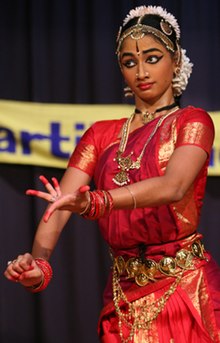Indian aesthetics
This article needs additional citations for verification. (December 2016) |
Indian art evolved with an emphasis on inducing special spiritual or philosophical states in the audience, or with representing them symbolically.
Rasas in the performing arts

The theory of
The expressions used in Kudiyattam or Kathakali are extremely exaggerated theatrical expressions. The opposite of this interpretation is
History
| Part of a series on |
| Hinduism |
|---|
 |
Natyashastra

Rasa theory blossoms beginning with the
Kashmiri aestheticians
The theory of the rasas develops significantly with the Kashmiri aesthetician Ãnandavardhana's classic on poetics, the Dhvanyāloka which introduces the ninth rasa, shānta-rasa as a specifically religious feeling of peace (śānta) which arises from its bhāva, weariness of the pleasures of the world.[citation needed] The primary purpose of this text is to refine the literary concept dhvani or poetic suggestion, by arguing for the existence of rasa-dhvani, primarily in forms of Sanskrit including a word, sentence or whole work "suggests" a real-world emotional state or bhāva, but thanks to aesthetic distance, the sensitive spectator relishes the rasa, the aesthetic flavor of tragedy, heroism or romance.
The 9th - 10th century master of the religious system known as "the nondual Shaivism of Kashmir" (or
Inclusion of bhakti
In the literary compositions, the emotion of bhakti as a feeling of adoration towards God was long considered only a minor feeling fit only for stotras, but not capable of being developed into a separate rasa as the sole theme of a whole poem or drama. In the tenth century, it was still struggling, and
Attention to rasas
Poets like
The Navarasas


- Śṛṅgāraḥ (शृङ्गारः): Romance, Love, attractiveness. Presiding deity: Vishnu. Colour: light green
- Hāsyaṃ (हास्यं): Laughter, mirth, comedy. Presiding deity: Shiva. Colour: white
- Raudraṃ (रौद्रं): Fury. Presiding deity: Shiva. Colour: red
- Kāruṇyaṃ (कारुण्यं): Compassion, mercy. Presiding deity: Yama. Colour: grey
- Bībhatsam (बीभत्सं): Disgust, aversion. Presiding deity: Shiva. Colour: blue
- Bhayānakaṃ (भयानकं): Horror, terror. Presiding deity: Yama. Colour: black
- Vīraṃ (वीरं): Heroism. Presiding deity: Indra. Colour: saffron
- Adbhutaṃ (अद्भुतं): Wonder, amazement. Presiding deity: Brahma. Colour: yellow[5]
Śāntaṃ rasa
A ninth rasa was added by later authors. This addition had to undergo a good deal of struggle between the sixth and the tenth centuries, before it could be accepted by the majority of the Alankarikas, and the expression "Navarasa" (the nine rasas), could come into vogue.
Shānta-rasa functions as an equal member of the set of rasas, but it is simultaneously distinct as being the most clear form of aesthetic bliss. Abhinavagupta likens it to the string of a jeweled necklace; while it may not be the most appealing for most people, it is the string that gives form to the necklace, allowing the jewels of the other eight rasas to be relished. Relishing the rasas and particularly shānta-rasa is hinted as being as-good-as but never-equal-to the bliss of Self-realization experienced by
See also
- Abhinaya
- Bishōnen – A Japanese beauty concept with influence from Indian aesthetic concepts
- Nātyasāstra– An ancient Sanskrit text on performance arts and aesthetics
- Nātyakalpadrumam
- Rasa lila
- Sanskrit Literature
- Sanskrit Theatre
References
- ^ Natalia Lidova 2014
- ISBN 978-1-4411-0381-9.
- ^ Wallace Dace 1963, pp. 249–250.
- ISBN 81-7080-076-5.
- ^ "The Navarasa". Retrieved 2012-04-22.
- ISBN 978-0-231-54069-8.
Works cited
- Wallace Dace (1963). "The Concept of "Rasa" in Sanskrit Dramatic Theory". Educational Theatre Journal. 15 (3): 249–254. JSTOR 3204783.
- Natalia Lidova (2014). Natyashastra. Oxford University Press. .
Further reading
- Sen, R. K., Aesthetic Enjoyment: Its Background in Philosophy and Medicine, Calcutta: University of Calcutta, 1966
- Sen, R. K., A Brief Introduction to a Comparative Study of Greek and Indian Aesthetics and Poetics, Calcutta: Sen Ray & Co., 1954
- Sen, R. K., Nature of Aesthetic Enjoyment in Greek and Indian Analyses, Indian Aesthetics and Art Activity, Simla: Indian Institute of Advanced Study, 1968
- Sukla, Ananta Charan, The Concept of Imitation in Greek and Indian Aesthetics, Calcutta: Rupa & Co., 1977
- Sukla, Ananta Charan, Understanding and Enjoyment in Aesthetic Experience, Journal of Comparative Literature and Aesthetics: 1978
- Sukla, Ananta Charan, Contemporary Indian Aesthetics, Milan (Italy): Rubberttino, 1995
- Sukla, Ananta Charan, Representation in Painting and Drama: Arguments from Indian Aesthetics, Journal of Comparative Literature and Aesthetics: 1992
- Sukla, Ananta Charan, Aesthetics Beyond/ Within Aesthetics: The Scope and Limits of Indian Aesthetics, Journal of Comparative Literature and Aesthetics: 1995
- Sukla, Ananta Charan, Rasa, Sringara and Sringara Rasa: Aesthetics as Mass Culture in Indian Antiquity, Lahti (Finland): 1995
- Sukla, Ananta Charan, Art, Nature and the Artifactuality of Art and Nature: A Plea for Environmental Aesthetics in Ancient India, Journal of Comparative Literature and Aesthetics: 1996
- Sukla, Ananta Charan, Art, Reality and the Reality of the Arts: Ontology, Representation and The Sister Arts Theory in Indian Aesthetics, Indian Response to Literary Theory, Delhi: 1996
- Sukla, Ananta Charan, Emotion, Aesthetic Experience and the Contextualist Turn, International Yearbook of Aesthetics: 1996
- Sukla, Ananta Charan, Dhvani as a Pivot in Sanskrit Literary Aesthetics, East and West in Aesthetics, Siena (Italy): 1997
- Sukla, Ananta Charan, Transculturality of Classical Indian Aesthetics, Frontiers of Transculturality in Contemporary Aesthetics, Turin (Italy): 2001
- Sukla, Ananta Charan, Contemporary Indian Aesthetics, Vishvanatha Kaviraja Institute (India): 1995
- Matthew Jones (January 2010). "Bollywood, Rasa and Indian Cinema: Misconceptions, Meanings and Millionaire". Visual Anthropology 23 (1): 33–43.
- Welch, Stuart Cary (1985). India: art and culture, 1300-1900. New York: The Metropolitan Museum of Art. ISBN 9780944142134.
External links
- Rasa (sentiments) and Bhāva (psychological states) - in the Natya-shastra
